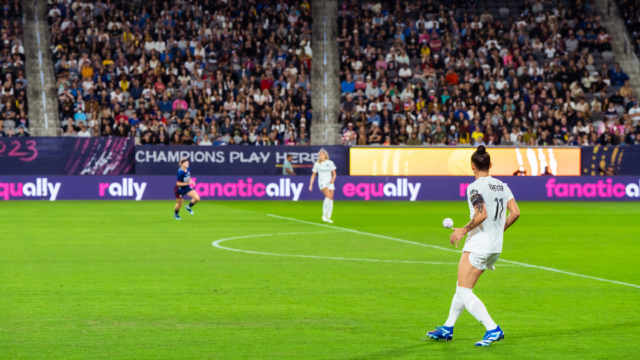Why Caitlin Clark Will Be Worth It for Nike
Inspiration meets innovation at Brandweek, the ultimate marketing experience. Join industry luminaries, rising talent and strategic experts in Phoenix, Arizona this September 23–26 to assess challenges, develop solutions and create new pathways for growth. Register early to save.
Caitlin Clark may soon receive an eight-figure payday from Nike. But brands have already known her value for some time.
As initially reported by The Athletic earlier this week, Clark is likely to sign her first professional shoe deal with Nike—her name, image and likeness (NIL) rights partner during her years at the University of Iowa. The deal, reportedly “worth well over $20 million plus potential bonuses,” would give Clark a signature shoe and keep Nike in Clark’s family of brands that includes fellow collegiate NIL holdovers State Farm and Gatorade, as well as fairly new supporters such as Panini and Gainbridge.
Why would Nike make Clark an offer that reportedly blew Adidas and Under Armour out of the running before she’s even played a second of professional ball?
Caitlin Clark is worth the money.
Kevin Krim, president and CEO, EDO
“Caitlin Clark is worth the money,” said Kevin Krim, president and CEO of television data and analytics company EDO. “She’ll be worth it for Nike, without a doubt. This is not a fluke. She’s had a consistent, sustained, positive impact for all these brands that she’s aligned with.”
Set aside the 45 collegiate records Clark broke during her career at Iowa, the 18.9 million viewers who watched her in the NCAA women’s final on ESPN (4 million more than watched the men’s title game), and the 2.45 million viewers who watched her WNBA Draft selection on Monday (nearly four times the previous draft record and the most-watched WNBA broadcast since 2000).
Clark spent her collegiate career showing the kind of value she could bring to NIL sports marketing partners, including Xfinity, Goldman Sachs, Hy-Vee and Buick. Even on draft night, Krim noted that the top-performing ads of the ESPN broadcast were two State Farm ads and one 45-second Gatorade spot—all featuring Clark.
According to EDO, ads shown during NCAA women’s basketball games with Caitlin Clark were 7% more effective than those that aired in games without her. During her 266 appearances in State Farm ads last year, for example, those spots were 46% more effective at driving engagement than the average State Farm spot and another 28% more effective when they aired during one of Clark’s games.
By comparison, Krim notes that during the last six seasons of seven-time Super Bowl champion Tom Brady’s career in the National Football league, ads shown during his games were just 8% more effective than those shown in games without him. While not quite the Taylor Swift Effect—which EDO said made Kansas City Chiefs games 14% more engaging for advertisers when she showed up to support Travis Kelce—Krim said Clark’s brand power for advertisers already exceeds New York Jets quarterback and Super Bowl champion Aaron Rodgers, who made viewers only 3% more likely to engage with ads during his games.
“She lifts all boats when she’s present, and that’s a real star effect,” Krim said. “It’s up there with the top stars we’ve seen over the last five-plus years.”
The next step
Brands like Nike also realize Clark’s greatest impact hasn’t been made yet.
Andrew Barrett serves as managing director at STS Capital Partners and worked with Formula 1, the PGA Tour, National Basketball Association, National Hockey League and Major League Baseball while in executive marketing positions at LG Electronics and Samsung. In assessing Clark’s value to brands like Nike, he pointed to Deloitte data from this year that found women’s elite sports will generate more than $1 billion in revenue for the first time, up 300% from 2021.
He pointed to a study by Wasserman’s women-focused practice, The Collective, showing that while the 15% share of sports media coverage dedicated to women’s sports is far greater than the long-assumed 3% to 4%, it’s still paltry considering women’s events comprise roughly 50% of all sports competitions in the U.S. Once athletes ascend to the professional ranks, as Clark has, coverage for women’s sports accounts for just 8% of sports media’s attention.
While Barrett sees this as an opportunity for Clark to become a pivotal figure within the WNBA and make “two or three iconic deals” that help her brand, he also views this as a moment of clarity for brands. With the price of media deals in men’s sports ballooning and more networks and streamers looking for content, he sees media rights deals for women’s sports escalating—which means brand sponsors must hop on board sooner to be part of the rise of its top stars.
“If the athlete’s use of your product helps them perform … it’s really important for a brand to find an athlete early on so someone can’t say, ‘Oh, you just sponsored her.’ You’ve actually helped build her performance from the very beginning,” Barrett said. “Certainly a brand like Nike, when they get an athlete early, people quickly assume that Nike has been part of helping that athlete progress.”
https://www.adweek.com/brand-marketing/caitlin-clark-shoe-deal-nike/

